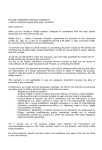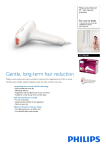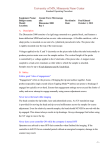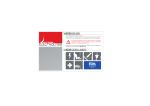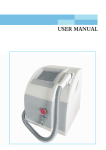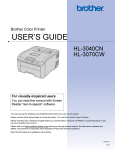Download Quick Setup Guide DM 2050
Transcript
beauty by DM 2050 Professional Laser Epilation Pen Quick Setup Guide Keep this user manual in a convenient place for quick and easy reference. The product names in this guidebook are trademarks or registered trade marks of each specific manufacturer. In the interest of providing superior equipment, Avance reserves the right to modify or amend equipment speci‐ fications without notice or obligation. DM4050 Features and Controls A B D C E F G A. Key Lockout: This feature is required by law on all high‐power laser devices. The first step in the correct sequence to power‐up your laser is to turn this lock clockwise using the special key included in your kit. The light (center LED lamp) will be green when the power system is off and red when the power system is on. B. System Status LED: This light will indicate system status (neutral or live). Green is neutral and red is live. C. Laser Jack: Connector provides power for the diode laser module. D. Carbon Dye: This is an ‘atomized’ form of molecular carbon which easily penetrates deeply into the follicle shaft. The dye adds pigment which gives a receptor for the photon/heat exchange reaction. (Required for treatment of blond and gray hair.) DermalPlast: A topical anesthetic that improves skin cooling and re‐ duces discomfort during treatment. (Recommended for all skin types.) Post‐Treatment Gel: A soothing gel that aids recovery of the skin and improves results. Apply thinly after each treatment for best results. E. Eyewear: This is an essential part of the treatment process. Direct or reflective laser radiation can seriously injure the eye. Both the techni‐ 2 beauty by F. G. cian and the patient must use the protective eyewear while the laser is enabled. Eyewear is intended for accidental exposure only. Never stare directly into a laser beam. High‐Precision Tweezers: Apparatus for the extraction of follicle prior to carbon dye application. Trigger Switch: This red button should be activated by way of the operator’s thumb. It will initiate laser pulses from the laser module. Laser Beam Trigger Switch Important Notice To preserve the life of your laser it is required that you allow a 2 sec‐ ond pause between each 1‐2 second emission (4‐9 pulses). Failure to comply with this usage requirement may cause permanent damage to your laser diode by heat buildup, which would not be covered by warranty. Using the laser module correctly will result in a life expectancy of the device exceeding 1,000,000 pulses which is approximately 1‐2 years of daily use. Warning!! The DM2050 emits a powerful focused laser beam which can be harmful to the eyes. Always wear protective eyewear while operating this equipment. Laser emission has the capability to burn the skin if the technician does not closely observe the patient’s reaction to the procedure. Laser treatments result in full destruction of the hair follicle and are irreversible. Always plan ahead before undertaking detail work such as eyebrow shaping or hairline contouring. Patch test a small area (no larger than 4cm2 or 1in2) before full application. Allow 24 hours to determine the patient’s reaction before applying full treatment. Handling Precautions The laser module can be damaged beyond repair if the handpiece is dropped or bumped sharply. Handle with care. 3 Laser Startup Procedure Before plugging your laser head into the power system, be sure the key switch is off (LED will show green). Failure to adhere to the A start‐up procedure may cause irreversible damage to your laser head (which would not be covered by warranty). B C A. Plug the laser module accessory into the power system. Place the laser head in a secure position POINTED AWAY from you and the patient. B. Power up your module by using your key lockout switch (turn to the “enabled” setting). C. A bright LED will begin flashing. Red ‘Enabled’ Your laser is now live and extreme care must be exercised while handling to avoid accidental eye‐exposure. The output of the laser is invisible (infrared) at 808 nm. Only 1% of the photon emission is made visible for the purpose of placement and/or focusing. The laser is very powerful and can cause serious eye injury if used incor‐ Pre‐Treatment Before applying treatment, remove all hair from the area by tweezing or waxing. Laser hair removal is most effective when applied to an empty folli‐ cle shaft. Human hair simply does not have enough pigment to allow for sufficient heat exchange to cauterize, desiccate and necrotize the cells which produce hair. To compensate for this lack of ‘quantitative’ and ‘qualitative’ photon targets, it will be necessary to place a high‐density car‐ bon dye inside the follicle prior to treatment. Isolate the hairs to permanently destroy. It will be necessary to remove them by swiftly plucking (or waxing) in the direction of growth. Pulling slowly generally leaves most of the follicle tissue inside the pore which will block the dye. The hairs may be left in the skin if desired, but results will be improved if they are extracted. 4 beauty by Photo‐Reactive Dye Application Using a cotton‐tipped applicator, completely cover the treatment area with the special dye included in your kit. Massage the dye into the follicle pore with a firm downward circular motion. Repeat 2‐3 times to satu‐ rate the follicle pore. Use an ethyl alcohol based wipe (isopropyl alcohol will not dissolve the dye) to lightly clean the excess from the surface of the skin. At this point you will have all desired follicles visibly high‐ lighted with a dark spot (as seen above) and are ready to power up your laser for treatment. Carbon dye must be also used if the hair is left in the skin for laser ‘shaving’. Pro Tip If your patient objects to having a depila‐ tory process before the treatment, you may continue without the carbon dye. This alternate procedure is the equiva‐ lent of ‘laser shaving’ (for which long‐ term permanency is marginal). For best results, the use of a photo‐reactive dye is highly recommended. Dermal Coolant Application Place a thin layer of laser dermal coolant spray on the treatment area prior to laser application. This will protect the surface of the skin from burning as well as improve the translucency of the skin (rate at which light can pass). Failure to use the dermal coolant prep may result in unnecessary discom‐ fort for the patient during treatment and increase the likelihood of a sur‐ face burn. Should the liquid become dry, it will be necessary to re‐apply frequently. The use of a humidifier in dry climates will substantially prolong the dura‐ tion for which the dermal prep will retain its cooling properties. 5 Treatment Procedure Shine the red dot on the highlighted hair follicle. Adjust the distance of the laser head from the tissue to create a pin‐ point of focus. The optimal beam diameter for maximum intensity is roughly 1 mm. The follicle will begin to flash as the photon energy reacts with the car‐ bon dye. It is also normal to see some gaseous emissions (vapor and smoke). Hold the laser in place until visible reactivity is reduced. A treat‐ ment time of 1‐2 seconds is recommended per follicle. Release the thumb switch and move on to the next follicle. Let the laser cool 1s between follicles. Some patients may find the laser treatment uncomfortable. In these cases the use of a topical anesthetic such as lidocaine (a local anesthetic) will re‐ duce discomfort. A mild cryogenic (nitrogen‐based) topical spray will also minimize any pain. Treatment Around or Near the Eyes: Great care must be exercised when working near the eyes. The laser emission is powerful enough to actually penetrate the eyelid and permanently damage the eye. Having the patient close their eyes is not satisfactory protection. The use of a dark‐colored damp wash cloth which is folded over four times will deflect the harmful radiation; however, only laser protective eyewear is recommended. Treatment Around or Near Mucus Membranes: Laser radiation will se‐ verely damage the tissues inside the nose and ear canal. Treatment should be avoided in these areas altogether. Treatment Around or Near the Genitals: Laser hair removal is safe for ap‐ plication to the pubic regions including the reproductive organs of both sexes. Care must be taken into consideration in these areas due to the in‐ creased level of neural sensitivity. The patient may find the process uncom‐ fortable without a topical. Treatment Around or Near the Areola (nipple): Laser hair removal is safe and effective on hair growth which occurs from the areola of both sexes. 6 beauty by Again, care must be taken in these areas due to the increased level of neu‐ ral sensitivity. Post‐Treatment: The skin surrounding the treatment area may experience short‐term erythmia (reddening) which will subside within 12 hours. Should the treatment area show signs of excess scabbing you may wish to reduce the overall treatment time or intensity. The application of a post‐ treatment cooling and healing gel (such as Aloe) is encouraged to speed healing and reduce sensitivity. Instruct the patient to refrain from applying cosmetics or sunbathing for at least 24 hours. Treatment Efficacy Permanent hair removal is a gradual process which takes 90 days or more for complete destruction of the follicle tissues. Each hair must go through its entire growth cycle for it to be effectively treated. Only during the early anagen phase is it before vulnerable to destruction. The following chart will give you an accurate example of what the reduction in growth activity should look like from 30, 60 , and 90 days of treatments. Human skin has roughly 1,000 follicles per square inch. Only a small percentage of them are active (anagen) at any given time. For effective treatment, the hair needs to be treated during the anagen phase. It normally takes about 90 days for each follicle to go through the full growth cycle. Should you see hair growth activity in an area which has been completely cleared, it is most likely from a follicle which was dormant at the time of the original treat‐ ment. Simply treat these hairs as they appear. Hair growth activity will normally stop within 3 months. after 30 days Patient # 1 females, 3 males 1 2 3 60 days hair counts pre 274 327 187 post 9 19 2 7 90 days 6 week clearance percent 97% 94% 99% How does Laser Hair Removal work? The first laser hair removal treatment was administered, quite by accident, by a technician in the late 1970’s. He was repairing a high output 692 nm YAG laser when he unwittingly left his arm in the beam’s path for a few sec‐ onds. Although his skin was completely unharmed, all the hair in the area had completely burned off. In the years to follow, the area of his arm which was exposed to the laser remained completely bald. What actually occurred was a “heat exchange” reaction with the pigment (called melanin) deep inside the follicle tissue. Photon energy from the laser had penetrated into the translucent dermis virtually unobstructed. When it reached the pigment natu‐ rally contained in the follicle, radiation quickly heated those cells (melanocytes) to well over 100 degrees Celsius. Human tissue cannot survive at this temperature; henceforth, the complete destruction of the follicle was virtually instantaneous. The scientific term for this process is called ther‐ molysis. Laser light with the wavelength of 600 to 900 nm (nanometer) passes through human tissue with very little loss of intensity. The Avance DM6050 Epilator produces a precise wavelength of 808 nm, which is proven to pro‐ vide the greatest tissue penetration while limiting the loss of energy to natural pigments found in the skin. Avance employs a long‐pulse laser, one of the most effective and sophisti‐ cated systems in the world. Long‐pulsed lasers use a series of short pulses to deliver laser energy to the follicle. The energy builds up in the dark pig‐ ments of the follicle, leaving the skin unharmed. Many other systems operate strictly on a single pulsed output. The problem with traditional pulsed lasers is that follicle tissues are only heated for a very small increment of time (usually less than 1/1,000,000 of a second). Recent clinical studies show that it can take a full two seconds or more for complete carbonization, desiccation and coagulation at around 80 degrees Celsius. The Avance DM2050 laser module may be held in position until full destruction is achieved. By carefully regulating the output at 808 nm, the laser will not harm the skin, even after extended treatment. 8 beauty by Will Laser Hair Removal work for me? The best candidate for laser hair removal has fair skin with dark terminal hairs. Skin typing for light‐based procedures (including laser hair removal) is usually done using the Fitzpatrick classification, developed by Dr. Thomas Fitzpatrick of Harvard Medical School. Type I Never tans, always burns (extremely fair skin, Type II Occasionally tans, usually burns (fair skin, Type III Often tans, sometimes burns (medium skin, Type IV Always tan, never burns (olive skin, brown/ Type V Never burns (dark brown skin, black hair, Type VI May burn (very dark/black skin, dark hair, Types 1 through 4 are outstanding candidates. Type 5 will have excellent results as well but care must be taken to assure that the laser will not burn the skin. This is achieved by using a cryogenic spray or air‐flow accessory. Type 6 should not undergo laser hair removal unless used in conjunction with skin bleaching due to the high risk of burning and hypo/hyper pigmen‐ tation issues. Warnings and Advisories The Avance DM2050 Epilator produces laser radiation which can be harmful to the eyes. Always wear protective eyewear while operating this equipment. Laser radiation has the capability to burn the skin if the technician does not closely observe the patient’s reaction to the procedure. Advisory: Laser hair removal results in full destruction of the hair follicle and is irreversible. Always plan ahead before undertaking detail work such as eyebrow shaping or hairline contour‐ ing. Patch test a small area (no larger than 1X1 inch square) before full application. Allow 24 This manual provides a tutorial overview of laser epilation. For more detailed information, please refer to “Modern Electrolysis, Volume 2, Phototherapy” by Palamed Press. If you are unsure of the proper use of this device, do not use. The Avance DM2050 Epilator is intended for use by 9 Troubleshooting Should you encounter technical problems with your Avance DM6050 Laser Epilator, refer to the following guide for potential problems and their solu‐ tions. Problem Solution The unit doesn’t turn on Check whether plugged into a working electrical socket. Unit is plugged into the wall, all Check all connections. Plug and accessories are correctly inserted unplug each one being sure all into the unit but no laser output is contacts are sound. being registered Check all cords. Due to continual bending and fatigue, wires may fray or break resulting is full loss of power. No output from the laser is regis‐ Unit needs servicing. Please con‐ tered after all trouble‐shooting tact customer service for assis‐ suggestions listed above have been tance. checked Laser beam is not focused to a us‐ Your optics need to be cleaned. able point (output is a weak line or Normally, the lens is pre‐set by oval) the manufacturer to focus at roughly 1‐2 inches from the aper‐ ture. If the user has altered this setting (removed or adjusted the end optics cap) without correct instructions the beam may be unusable until corrected. Unit hums or makes noises Laser output is weak Unit needs servicing. Please con‐ tact customer service for assis‐ tance. 10 beauty by Important Safety Information Read all safety and operating instructions before connecting or using this equipment. To protect against electrical shock, DO NOT use this equipment near water. DO NOT immerse unit, plug transformer while standing in water, or spray with any liquids. As with many electrical appliances, this unit carries a live charge even while unplugged. DO NOT dismantle this unit (there are haz‐ ardous voltages inside). DO NOT place this unit near an open flame or cooking/heating devices (e.g., stoves, heat registers, radiators, etc.). If an extension cord is used, it should be appropriately rated for voltage, power, and frequency as indicated on the back of the unit. The power cord should be routed so that it is not likely to be walked upon or pinched (especially near the wall outlet, extension receptacle, or where the cord exits the unit). To avoid serious damage to the power system and microelectronics, the transformer should be unplugged from the wall outlet when the unit will be unused for long periods of time. Equipment Warranty We warrant to the original purchaser the equipment manufactured by us to be free from defects in material and workmanship under normal use and service. Our obligation under this warranty shall be limited to the repair or exchange of any part or parts which may prove defective under normal use and service within 12 calendar months from the date of shipment and which our examination shall disclose to our satisfaction to be thus defective. When necessary, purchaser shall apply for a Return Materials Authorization and instructions on proper return procedures from their original sales associate. The laser diode (head) requires special operating precautions which, if defied, may void warranty. Warranty Extension Certification: Customer Number Warranty Extension Authorization Number ( ) years 11 Warranty Type: A B C D Replacement Parts and Supplies Laser Eyewear PL‐213‐1100 $99.95 each LM2050 Replacement Laser LM‐225‐2050 $399.95 each Carbon Dye (50ml) SP‐213‐2500‐50mL $29.95 each DermalPlast (50ml) SP‐213‐3500‐50mL $29.95 each Post‐Treatment Gel (50ml) SP‐213‐4500‐50mL $29.95 each All prices in USD. Delivery F.O.B. Prices subject to change without notice. To order online, visit our website: http://www.centre‐biotechnique‐avance.com/ For technical assistance beyond what this manual provides, please e‐mail admin@centre‐biotechnique‐avance.com Please allow 24 hours for processing. Avance Beauty Toronto, Ontario © 2012 Avance Beauty UL8529001 Printed in USA














